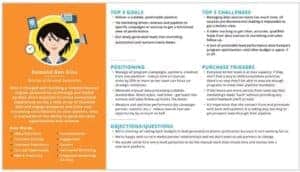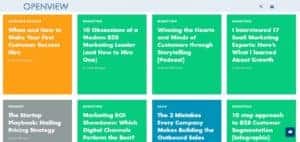
Samuel Wheeler, SEO manager, Inseev Interactive
In the early days of content marketing, simply having a business blog with any level of generic content put companies ahead of the competition. Now that nearly every business has a blog (and basic information is easy to find), busuiness-to-business content marketing is an increasingly competitive and personalized business environment. Effective and unique B2B content is notoriously difficult to create, and B2B blogs often fail far more quickly than business-to-consumer blogs.
Many B2B blogs try to create content with a B2C approach, which seems logical—after all, the businesses in the target audience are also consumers. However, B2B content marketers often fail to see the decision makers as consumers acting on behalf of a business, and instead just target them on an individual level.
The B2B Target Audience
B2C marketing relies heavily on buyer personas that establish a detailed profile of the ideal customer or client. Demographics like gender and income level are influential. In B2B marketing, buyer personas are no less important, but require a different approach to be effective. B2B buyer personas must start with a detailed profile of the ideal client company, which looks at characteristics like company size, revenue and location.
Once a marketing team develops business buyer personas, they must is also build personas for the key decision makers within e target companies. Who at the company are you trying to appeal to? Where do decision makers go to explore purchasing decisions? This is trickier than building a B2C persona, because personal demographics like age and gender may not be consistent across target companies. If a niche has a demonstrated demographic trend, it may be possible to narrow personas by personal demographics, but work-related identifiers are more likely to be effective. Other factors to include in a decision maker persona include seniority, team size, and departmental budget, as in this sample persona from marketing services firm Integrate:

Identifying and understanding the individual characteristics of decision makers is the key to B2B marketing. Business needs drive purchasing decisions, but people gather the information to make the decision. Businesses don’t read blogs—ppeople do.
Must-Have Attributes for B2B Content
B2B content must always answer the questions of decision-makers in target businesses. B2B companies must understand their niche and the problems facing decision-makers within it. To be truly effective, however, it must always address these issues through what is overall best for business interests and the bottom line.
Actionable Work-Related Tips
Commentary and opinion pieces have little use in B2B content marketing. Readers need content to help them improve their work and their processes; otherwise, it is a waste of time to both creator and reader. Creating thorough target personas should address specific problems or challenges facing decision makers in a target business.
Sales-oriented content will lose readers very quickly. This is the seemingly paradoxical principle that trips up many B2B marketers: non-sales oriented content is the key to increasing sales.
Here are some examples of excellent action-oriented articles from B2B blogs:
- Workplace Love: Developing Effective Office Camaraderie from BambooHR
- 10 Ways to Prevent Admin Tasks from Draining Your Creative Energy from Dropbox
- How New Customers Find Your Restaurant from Square
All of these articles address a specific topic important to the target audience, and provide concrete tips for putting the information into action. When developing content, ask yourself if the article could be used to train a new hire or for a professional development meeting. If the answer is no, really examine what value it adds to the target audience.
Not every post will appeal to every persona, nor should it. Segment your content strategy and divide each article up into categories so each type of decision maker can easily find the content pertinent to them. Similarly, understand and acknowledge that your product may not be the right solution for every customer: this builds brand trust.
Understanding Industry Trends
It’s imperative to understand key industry trends and challenges. Dig into relevant research and stay on top of newsworthy events, especially changes to laws and regulations that may affect customers. Pay attention to social media and the main influencers in the target industry to see what technologies or methods are trending or changing. This demonstrates an understanding of the industry and how outside factors may affect target businesses.
Additionally, leverage existing content strategies to help shape future ones. Measure traffic to existing blog posts and track social media shares and comments to identify useful content. Pay attention to where and how readers interact with content: while Twitter and LinkedIn are more common social platforms for B2B companies, some niches may find success on Facebook or Instagram.
Exciting and Compelling Tone and Style
B2B content is often thought of as boring and dry—and if it is, no one will read it. Professional and formal writing can still make for an interesting read, and excellent writing skills will go a long way in this regard. Don’t be afraid to make industry-relevant jokes here and there or refer to current events or well-known stories. Always provide new insights or angles on common topics, and break up text with subheadings and images that make the content easier to read and digest. Here are three B2B blogs known for their compelling style:
Various Content Formats
Blog posts are just one way to reach potential buyers, and B2B content can take a variety of forms. Providing additional resources in the form of infographics, tutorial videos, or templates and tools adds great value to the reader and can give them a better grasp on how your product works and may compel them to become customers.
Consider creating a resource center to host all B2B content. This can include blog posts and allows you to incorporate additional resources into the overall content strategy. It also conveys authority and trust because of the variety and complexity of content you host there.
Resource centers can host a variety of content, but to maximize their effectiveness they must be well-organized and easy to navigate. Content should be organized by both format and topic so the website becomes a well-known and easy-to-use place to find the best and most relevant content in the target industry. OpenView Partners, a software industry research and advisory firm, offers a great example of this, by color-coding their topic categories and clearly indicating the non-text formats, such as podcasts and infographics, in the titles:

Here are some other examples of companies with great resource centers:
- TransUnion’s ShareAble for Hires Hiring Resource Center
- 99Designs Resource Center
B2B content marketing requires detailed strategizing that considers the needs of both target businesses and decision makers within those businesses. It must answer individual questions about corporate goals and enable individuals within those companies to contribute to meeting those goals. Creating compelling B2B content relies on understanding the target businesses, the industry as a whole, and how to convey action-oriented content to those decision makers in a format that’s easy for them to digest. Varying content formats and designing blogs as resource centers adds value to the content marketing strategy and can reach a wider range of decision makers in the B2B audience.
Samuel Wheeler is SEO manager and a digital marketing expert at Inseev Interactive, a digital marketing agency. He has worked with both large and small brands. When he is not in front of a computer screen you can find him off the coast of California, surfing the evening swell.
Favorite